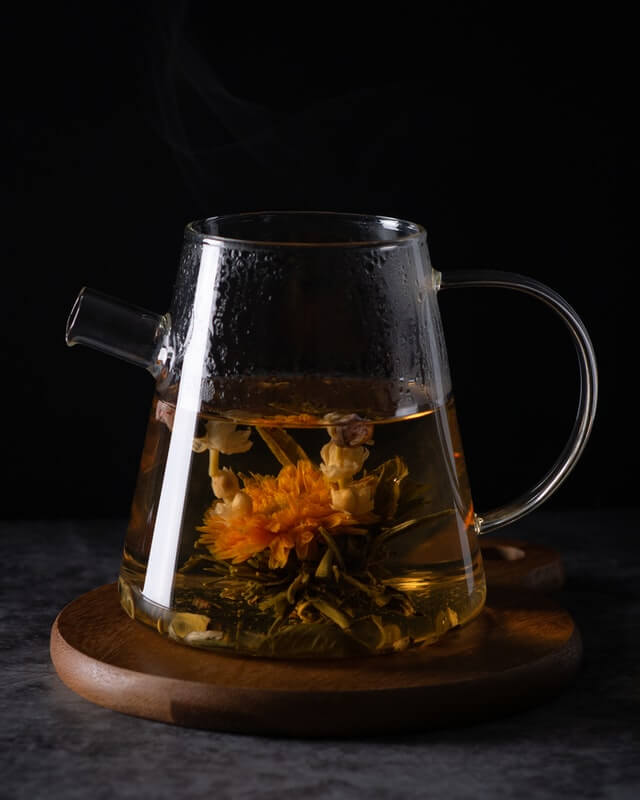Flowering Tea
Your Guide to Flowering Tea
Flowering, or blooming, teas are composed of thin strips of white or green tea wrapped around sweet edible flowers and worked into delicate bulb-like balls before being baked at low temperatures to dry. These handmade tea flowers are created by skilled artisans in the main tea-growing regions of China. Flowers with wonderful floral notes, such as jasmine, amaranth, chrysanthemum, hibiscus, osmanthus, marigold and lavender, are used in this unique process.
The History and Production of Flowering Tea
In their current form, flowering teas were first developed in China during the 1980s, although certain sources suggest that the practice of forming bundles of tea leaves in this way is centuries old. Typically sourced from the Yunnan, Anhui and Fujian provinces of China, flowering teas have come to be revered as a true piece of craftsmanship in the world of teas.
Flowering teas are made using fine raw materials and are often prepared by artisans who have years of experience. These artisans can create very precise, expertly constructed flowering tea bundles, displaying the skills of a delicate hand and wonderful intricacy. When creating the typical ball-shaped tea bundle, a flowering tea-maker will begin with buds, some fine thread and flowers (jasmine is a popular flower, as is amaranth.) The buds used need to be long enough, with large enough leaves, to allow the construction of the bundles, which are structured around a central flower and secured with the thread. Finally, the buds are gathered up and wrapped in cloth to secure their distinctive shapes.
When brewing a flowering tea, it is best to use a glass teapot so that the slow unfurling of the carefully prepared bundles can be fully enjoyed. Bundles can unfurl to reveal a wide range of shapes and flower combinations, colours and aromas – it truly is an artform in tea-making.
Types of Flowering Tea
One of the beauties of flowering tea is the wide range of stunning flower combinations that can be created, each displaying a unique bouquet of colours, shapes, flavours and aromas. Our Tiger Leaping Flowering Tea is a luxury green tea, made with lily, jasmine and osmanthus blossoms, sourced from the Yunnan Province, which reveals wonderful peach, lily and jasmine aromas. Jinicun Mountain Flowering Tea is made with amaranth, marigold blossoms and mint leaves to reveal refreshing peppermint notes and a sweet floral finish, while Lily’s Love Flowering Tea uses jasmine, amaranth and lavender blossoms to create great floral notes of jasmine and lavender.
Our Lotus Peak Flowering Tea is refreshing and cleansing, made with amaranth, hibiscus and lavender blossoms, while our Mountain Dream Flowering Tea, sourced from the Anhui Province of China, uses amaranth and jasmine blossoms for a fresh and delicate tea. Finally, our Summer Blossom Flowering Tea, sourced from the Fujian Province of China, is made with jasmine and marigold blossoms and offers light flavours with delicate floral notes.
FAQs
How should I prepare flowering tea?
Flowering teas are simple to prepare. A medium to large sized glass teapot is best used to display the beauty of the tea flower as it comes to life. Firstly, heat some water; the delicate nature of white and green teas require water heated to lower temperatures than other teas - between 66°C-85°C (150ºF-185ºF) for green teas and 80ºC-85ºC (176ºF-185ºF) for white teas. Filtered or spring water is preferable, especially in hard water areas. Four cups of water to one blooming tea ball should be adequate. Place the flowering tea ball in the teapot and carefully cover it with the water. Within a few minutes you will see the tea flower transform; it's a sight to behold as the leaves gently unfurl and expand to reveal the beautiful bloom within. How long you leave the tea flower to steep depends on how you like your tea. It may require a little experimentation with steeping times to achieve the depth of flavour you require. Pour into cups and sweeten if desired. Tea flowers can be re-steeped once or twice again after the first infusion.
Where can I buy the best flowering tea?
If you’re looking for the best flowering teas, Tea-Direct has some fine, high quality varieties available in a range of wonderful flower combinations and stunning arrangements.


